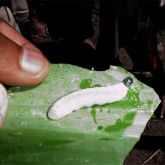Banana skipper butterfly
Alert
Banana skipper butterfly larvae were collected on Saibai Island in the Torres Strait on 11 May 2021 during routine surveillance activities.
Banana skipper is a Category 4 Emergency Plant Pest under Schedule 13 of the Emergency Plant Pest Response Deed and is listed as Prohibited Matter in the Biosecurity Act 2014.
If you suspect you have found banana skipper butterfly in Queensland, report it to Biosecurity Queensland on 13 25 23 or contact the Exotic Plant Pest Hotline on 1800 084 881.

Damage to banana plant by caterpillar of the banana skipper, Erionota thrax
Department of Agriculture and Fisheries

Banana skipper (Erionota thrax)
Walker, K. (2005) PaDIL

Larvae (Erionota thrax)
Walker, K. (2005) PaDIL
Banana skipper butterfly (Erionota thrax) is a high priority pest of bananas.
Caterpillars damage banana plants by shredding leaves and making numerous rolls of the leaf blade, up to 15cm long, to feed safely inside them. Damage of up to 60% of the leaf area of banana plants has been recorded during outbreaks.
Banana skipper butterfly poses a significant threat to Australia's banana industry.
Cause
Banana skipper butterfly (Erionota thrax).
Damage is caused when caterpillars shred and roll leaves to shelter and feed.
Other names
- Banana leafroller
- Erionota thrax
Description
Adult butterfly
- Brown with 3 yellow-white areas at the front of wings.
- Wingspan approximately 7cm.
- Most active in early evening.
- Move in fast, darting, skipping motion.
- Attracted to light.
Larvae
- Shred banana leaves and cause leaf rolling.
- Shiny black heads, narrow necks and pale green bodies.
- Covered in white waxy powder.
- Grow to 6cm.
Pupae
- Found inside leaf roll.
- Covered in white waxy powder.
Eggs
- Small, yellow.
- Laid singly or in batches up to 25 on underside of banana leaves.
Plant damage
- Rolled up leaves extending to 15cm.
- Fine white powdery substance in rolled up leaves.
Distribution
Widespread in South East Asia, also found in Papua New Guinea, Mauritius, Guam and Hawaii.
Banana skipper butterfly has not previously been recorded in Australia. However, DAF is responding to a detection of the pest on Saibai Island, which is part of Queensland located just 4km south of Papua New Guinea. Saibai Island is over 700km from the nearest Australian commercial banana production area.
Hosts
- Banana
- Musa species, including Manila hemp (Musa textalis)
Life cycle
Several generations may be produced during a year. Eggs are laid singly or in groups of up to 25 on the underside of banana leaves and hatch after 5–8 days.
There are 5 larval stages over 30 days. Later larval stages are covered in a white waxy powder. Larvae spin strong threads, shred leaves and roll them into a shelter to hide and feed.
Pupation occurs inside the leaf roll and takes 8–12 days.
Impacts
Damage of up to 60% of the leaf area of banana plants has been recorded during outbreaks. If the outbreak comes at the time of fruiting, yields are lower due to delayed fruit maturity and reduce bunch size.
Heavy infestations can lead to complete defoliation of banana plants.
How it is spread
The greatest risk of pest spread is through moving infested plant material with eggs attached to leaves.
Adult moths may also hitchhike in vehicles, machinery or aircraft.
Strong winds may assist adult moths to travel outside localised areas.
Monitoring and action
Inspect your plants regularly for the presence of new pests and unusual symptoms.
If you suspect banana skipper butterfly report it to Biosecurity Queensland on 13 25 23 immediately.
Further information
- Read the Plant Health Australia banana skipper butterfly fact sheet (PDF, 642KB).